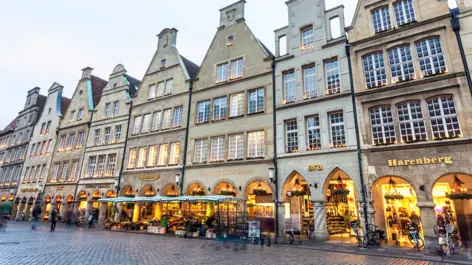Centrally located between the old town and the promenade
Münster in Westphalia is famous for its reconstructed old town with its mighty cathedral and its bike-friendliness. H.ostel Münster is centrally located in the southern part of the old town, only about one hundred metres from the promenade: Ideal for exploring the city on foot or by bike. If you are arriving by train at the main railway station, it is just a ten minute walk to H.ostel Münster.

Old town with Lambertikirche
Take advantage of H.ostel Münster’s central location and simply walk the 600 meters to St.-Paulus-Dom. The present cathedral dates back to the 13th century and combines elements of Romanesque and Gothic architecture. The different architectural styles of the Westwerk and in the adjacent Basilica are easy to distinguish. The cathedral chamber, where works of art spanning 12 centuries are exhibited, is well worth a visit.
On Wednesdays and Saturdays the Münster weekly market takes place in front of the cathedral, which is a popular meeting place. Just a few minutes away is the Lambertikirche, which was financed by merchants as a "counter church" to the episcopal cathedral and originates from the 14th century.
The Lambertikirche is located on the Prinzipalmarkt, a shopping street with arcades and gabled houses from the 12th century, which invites you to take a stroll through the stores. The historical town hall with the "peace hall" is also here. This landmark of the city, from 1643 onwards, is where negotiations took place for the Peace of Westphalia until the Peace of Münster was signed in 1648.
Due to its historical importance, the town hall was awarded the European Heritage Label. The town hall is open for visits daily and is a five-minute walk from H.ostel Münster.

Prinzipalmarkt

The Pablo Picasso art museum is well worth a visit for visitors to the city of Münster who are interested in art. The collection includes nearly his entire lithographic works, as well as special exhibitions on the life and work of the artist, but also on his contemporaries. The lithography made it possible for Picasso to record versions of his paintings in the development process.
Some of the picture themes and motif series, ranging from portraits of still lifes to the famous bull-fighting scenes, have been created over the years. In addition, graphics by Georges Braque and Marc Chagall and artist books by Max Ernst or Henri Matisse are on display here. The museum is less than a five-minute walk from H.ostel Münster.
The Prince Bishop’s Münster Castle was built in the 18th century by the architect Johann Conrad Schlaun. Since 1954, the high baroque residence made of light and red sandstone has been the location for the University of Münster. The castle park is a popular meeting point for students. The botanical garden behind the castle, which is open to the public, is also well worth seeing.
A highlight is the "Tournament of winners" horse show set against the historical backdrop, which is held in summer on the vast palace square. When the "Send" folk festival takes place, a firework display is set off on the square. You can cycle over the promenade from H.ostel Münster to the castle in just five minutes.

Münster Castle

The Erbdrostenhof Münster is a Baroque noble palace in Salzstraße, which was built between 1753 and 1758 by the same architect as the castle. You can access the house on the corner plot via the triangular forecourt. The representative design and the magnificent Baroque ballroom, which stretch across the entire central block, are remarkable. Events and concerts are held here nowadays.
The foyer is open for visits on weekdays, house tours and guided tours are available by appointment and on selected days in the year. It is a 3-minute cycle from H.ostel Münster and just an eight-minute walk.
